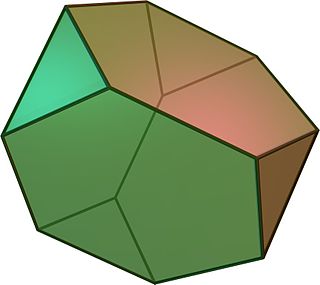Truncated tetrahedron
| Truncated tetrahedron | |
|---|---|
 (Click here for rotating model) | |
| Type | Archimedean solid Uniform polyhedron |
| Elements | F = 8, E = 18, V = 12 (χ = 2) |
| Faces by sides | 4{3}+4{6} |
| Conway notation | tT |
| Schläfli symbols | t{3,3} = h2{4,3} |
| t0,1{3,3} | |
| Wythoff symbol | 2 3 | 3 |
| Coxeter diagram | |
| Symmetry group | Td, A3, [3,3], (*332), order 24 |
| Rotation group | T, [3,3]+, (332), order 12 |
| Dihedral angle | 3-6: 109°28′16″ 6-6: 70°31′44″ |
| References | U02, C16, W6 |
| Properties | Semiregular convex |
 Colored faces |
 3.6.6 (Vertex figure) |
 Triakis tetrahedron (dual polyhedron) |
 Net |
In geometry, the truncated tetrahedron is an Archimedean solid. It has 4 regular hexagonal faces, 4 regular triangular faces, 12 vertices and 18 edges.
Area and volume
The area A and the volume V of a truncated tetrahedron of edge length a are:
Cartesian coordinates
Cartesian coordinates for the 12 vertices of a truncated tetrahedron centered at the origin, with edge length √8, are all permutations of (±1,±1,±3) with an even number of minus signs:
- (+3,+1,+1), (+1,+3,+1), (+1,+1,+3)
- (−3,−1,+1), (−1,−3,+1), (−1,−1,+3)
- (−3,+1,−1), (−1,+3,−1), (−1,+1,−3)
- (+3,−1,−1), (+1,−3,−1), (+1,−1,−3)
 The set of vertex permutations (±1,±1,±3) with an odd number of minus signs forms a complementary truncated tetrahedron, and combined they form a uniform compound polyhedron. |
 Orthogonal projection |
Use in architecture
Giant truncated tetrahedrons were used for the "Man the Explorer" and "Man the Producer" theme pavilions in Expo 67. They were made of massive girders of steel bolted together in a geometric lattice. The truncated tetrahedrons were interconnected with lattice steel platforms. All of these buildings were demolished after the end of Expo 67, as they had not been built to withstand the severity of the Montreal weather over the years. Their only remnants are in the Montreal city archives, the Public Archives Of Canada and the photo collections of tourists of the times.[1]
See also
References
- Williams, Robert (1979). The Geometrical Foundation of Natural Structure: A Source Book of Design. Dover Publications, Inc. ISBN 0-486-23729-X. (Section 3-9)
External links
- Weisstein, Eric W., "Truncated tetrahedron" ("Archimedean solid") at MathWorld.
- The Uniform Polyhedra
- Virtual Reality Polyhedra The Encyclopedia of Polyhedra


